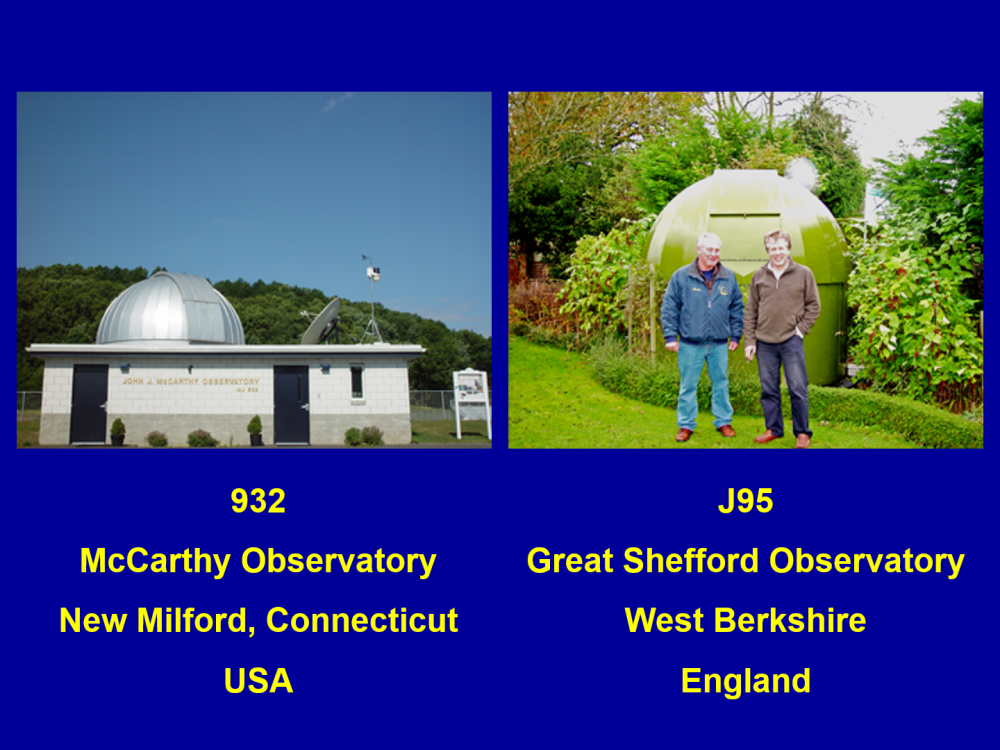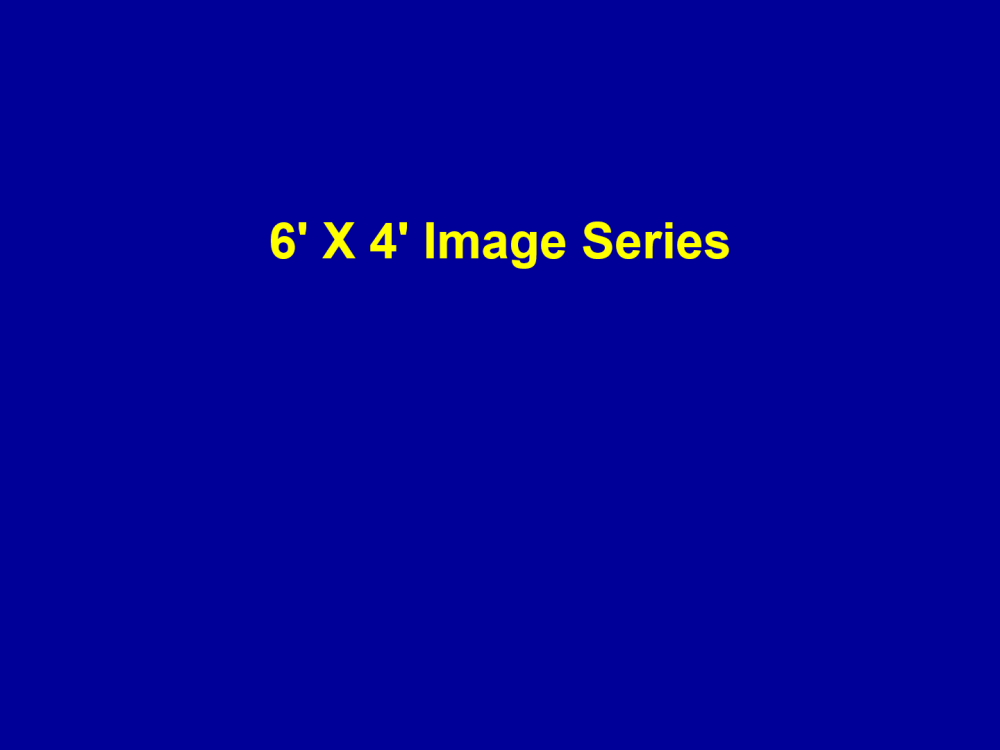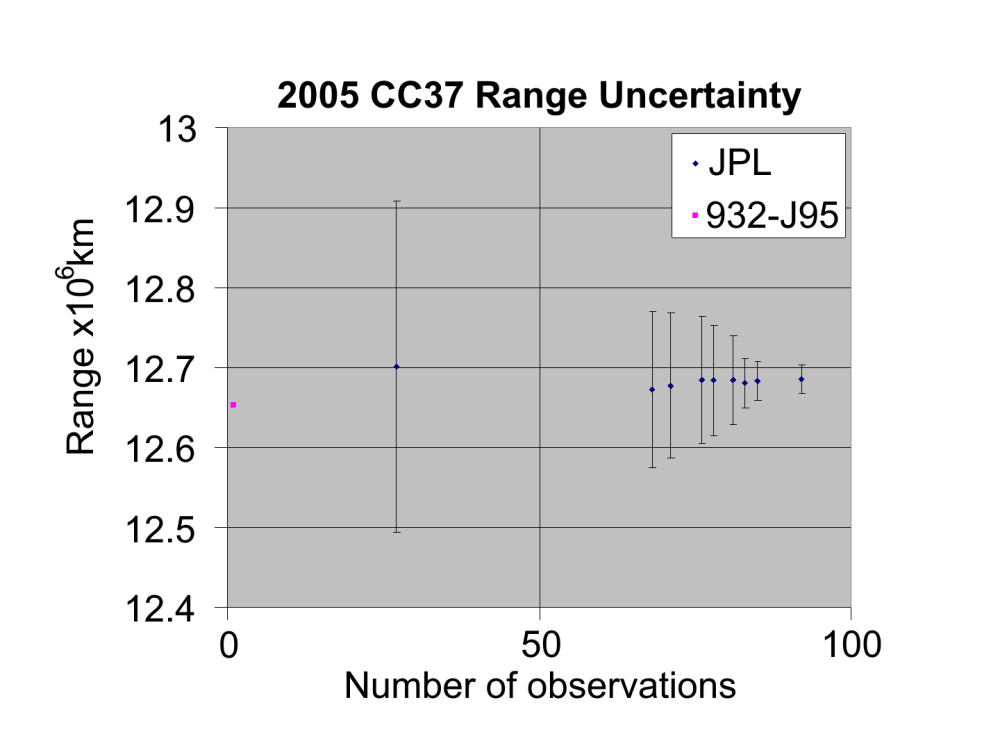|

[Comments by M. Robson]
Hello, Iím Monty Robson from 932, the McCarthy Observatory in Connecticut
in the United States. Thank you for having us at this fine conference.
I am here with Peter Birtwhistle to speak about our ongoing project to
range Near Earth Asteroids. We hope it will be as exciting to you as it
is to us.

Here are the two observatories.
The McCarthy Observatory is located on a high school campus in
Connecticut and it is primarily an educational facility. It is located
about half way between Boston and New York City.
On the right is J95, the Great Shefford Observatory in south central
England, not too far from Stonehenge. This picture shows me, Monty
Robson (left) and Peter Birtwhistle (right) in front of J95 in November
2005. Ever since Great Shefford began operations it has been a leader in
confirming newly discovered NEOs.

In 2002 and 2003 it was my pleasure to mentor a wonderful young
student during the research portion of her science fair project. Miss
Lisa Glukhovsky is shown here with Dr. Brian Marsden, Director of the
Minor Planet Center. They were both invited to speak at a meeting of the
Rhode Island Astronomical Society, Skyscrapers.
Lisaís project was entitled A Rapid, Accurate Method of Determining
the Distance to Near-Earth Asteroids. Her project won many awards
including winning one of the worldís largest science fairs, the Intel
International Science and Engineering Fair.
Lisa used simultaneous CCD imaging between observatories separated by
a long baseline distance to determine the objectís parallax and then
derived its distance. Peter and I are using the same basic technique,
but are using improved equipment and software and have improved
procedures.

Here are some of the projectís statistics.
24 simultaneous or nearly simultaneous observation pairs of nine
different newly discovered NEOs have been reported to the MPC.
3 NEOCP objects, objects on the Confirmation Page of the MPC, were
reported.
The mean range difference between our projectís derived range and the
range published in the Horizons Ephemeris service from the Jet
Propulsion Laboratory was 0.41%. Our mean astrometric residual was 0.35
arc second for the project to date. Our mean timing error was 0.36s. 932
uses a GPS-based time and J95 uses a corrected Internet-based time.

This is a chronological summary of our projectís observations.
The nearest object observed was at a range of 0.047 AU and the most
distant object was at a range of 0.313 AU.
I want to point out that there is little or no correlation between an
objectís range and the percentage of range difference between our
derived range and JPLís published range. In other words, no matter how
far away an asteroid is our project range is within 0.5% of JPLís range.
There is, of course, a correlation between the range difference and
the range to the NEO. The range difference between our derivation and
JPLís range increases with increasing target range.

This slide shows the spreadsheet we use to determine range to the
target. Peter also uses other software, including FindOrb.
Data is only entered into the yellow boxes. Answers are given in
either the blue boxes or the lavender box.
The date and decimal day time are entered first. Then the two
observing stationís elevation, east longitude, and latitude are entered
to calculate the baseline length (a chord line distance through the
Earth). Then the targetís astrometric coordinates from the MPC report
are entered. This gives the parallax in degrees and is converted into
range. Ranges shown are: R1, range from target to station 1; R2, range
from target to station 2; R is range from target to the geocenter.

I would like to introduce my collaborator and friend, Mr. Peter
Birtwhistle. Most of you know him and he doesnít really need an
introduction; I think he is the best there is at finding and confirming
newly discovered near-earth objects. All of us at 932 have learned a lot
from working with Peter, we are a more capable observatory from the
experience. PeterÖ
[Comments by Mr. P. Birtwhistle]
Good afternoon.
This page is showing simultaneous observations of a NEO. The
spreadsheet that Monty showed relies on the fact that the observations
are simultaneous or nearly so, preferably to the second. So we spent a
bit of time finding the way to do this, in practice itís not
straightforward.
For the first little while we were emailing to coordinate our
observations. Trying to arrange observing sessions, with the number of
communications required, using email was almost impossible. So a few
weeks into the project I suggested using instant messaging over the
Internet as the way to communicate. It made things much easier.

Next is a series of our images.

This is the first target we went for. At the time I was still using
my 12-inch telescope, Montyís is a 16-inch. The pixel scale is
different, but we tried to show the same field of view.
This is an example of a rather large parallax of 117 arc seconds.

Here is 2004 VD17 showing a rather small parallax of 23 arc seconds
since it was a fair distance away.

This animation toggles between the 932 image and the J95 image.

This is a set of five simultaneous images of a relatively bright NEO
with a moderate parallax of just under 70 arc seconds.

This was one that was on the Confirmation Page when we were going for
it.

This was a fainter object so we had to stack images using
Astrometrica (software) to see it. It is much easier to work with
targets that can be seen on individual images.

Here is the MPEC announcing the confirmation of 2005 CC37. Our timing
was slightly off, the fifth digit of a decimal day is about 0.8 seconds.

This is a time frame of the history of 2005 CC37 observations.
20 minutes after appearing on the NEOCP, J95 sends the MPC a
confirming report. This is 2 hours 24 minutes after discovery.
When it is dark enough at 932, we try to simultaneously image the
asteroid. The first joint observation takes place 3 hours 42 minutes
after discovery.
4 Ĺ hours after discovery we had a range to the target Confirmation
Page object. This range stayed within JPLís 3 sigma range uncertainty
for 21 days. In other words, it took three weeks and almost 90
observations of 2005 CC37 before its orbit was known well enough for our
early range determination to fall out of JPLís range uncertainty.

This is the spreadsheet for one of our 2005 CC37 observations.

This is a graph showing the way 2005 CC37ís range uncertainty
decreased as more observations were reported.
Blue diamonds represent JPLís range. The range uncertainty is shown
as error bars above and below the blue diamonds.
The magenta square on the left represents our project range, 4 Ĺ
hours after discovery.

This graphic shows, at first, a large uncertainty area for an
asteroid observed by only one station.
If simultaneous observations are conducted from two (or more)
observatories the uncertainty area is greatly reduced.

This slide and the following two slides illustrate the power of the
technique of simultaneous imaging to quickly refine the orbit of a newly
discovered object.
What I show here are the residuals for both J95 and 932 from FindOrb.
The FindOrb orbit was calculated using only J95 observations, then the
932 observations were evaluated. Notice the very high residuals from
932. It is obvious that this orbit solution is not representing Montyís
observations very well.

Putting 932ís observations into the Findorb orbit solution you get
the accuracy of the parallax. Here are the residuals for the same
observations when FindOrb includes all of them for orbit determination.
J95ís residuals change slightly, but 932ís residuals are drastically
reduced. Now the orbit represents all observations very well.

Using my 8 observations, taken over a time span of 1 hour 45 minutes,
for orbit determination, FindOrb returns a range to 2004 XJ of 0.0410
AU. But when 932ís observations are included in the solution FindOrb
gives a range of 0.0472 AU for the same time span. This is very close to
JPLís range, 0.0471 AU, at the time of our observations, when using all
75 observations collected over a 13 day arc. This demonstrates the power
of observing new objects at the same time.
There are limitations to this project. Weather at both stations must
be acceptable. We are 5 hours apart in longitude and 10 degrees
different in latitude. Targets have to be visible from both stations. In
the summer months it is difficult to image together since morning
twilight sets in at J95 as it is getting dark at 932. In many situations
it may be preferable to use stations orientated on a north-south
baseline, rather than an east-west baseline as in our case. Maybe an
observatory in South America would be a good match for North American
stations, likewise a southern Africa site may be well suited for those
in Europe.
As for requirements for participants, accurate observatory time and
Internet access while observing seem to be most important.

[Comments by Robson]
We would be happy to answer any questions you may have about this
project.
We would welcome the participation of others in the project.
|